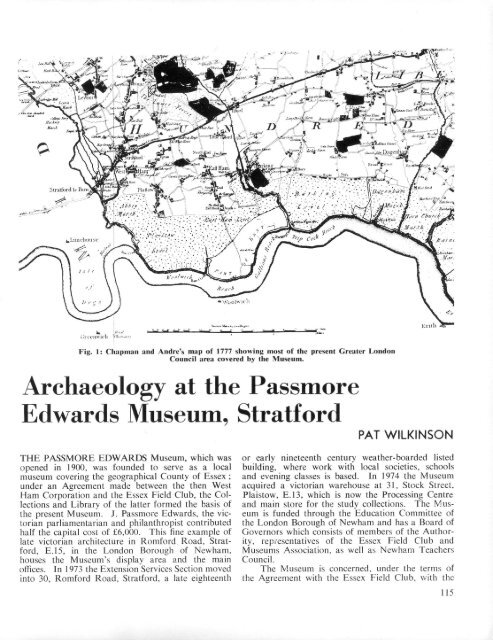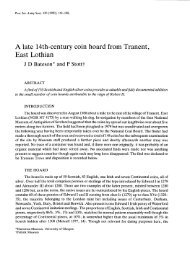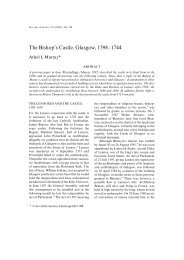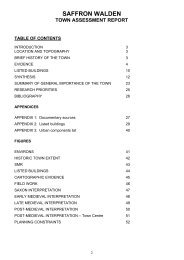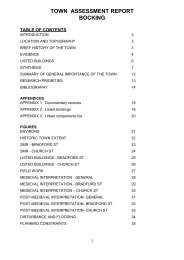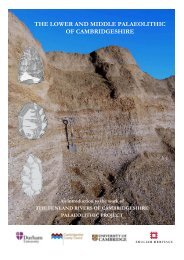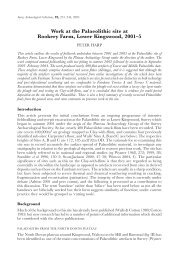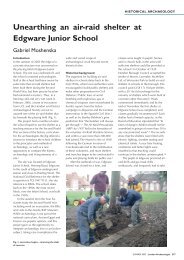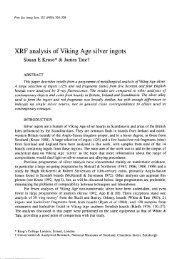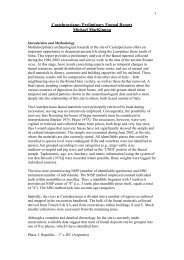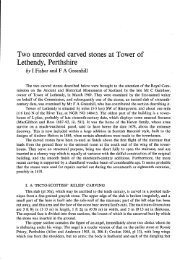Archaeology at the Passmore Edwards ~ useum , Stratfor - Internet ...
Archaeology at the Passmore Edwards ~ useum , Stratfor - Internet ...
Archaeology at the Passmore Edwards ~ useum , Stratfor - Internet ...
You also want an ePaper? Increase the reach of your titles
YUMPU automatically turns print PDFs into web optimized ePapers that Google loves.
Fig. l: Chapman and Andre's map of 1777 showing most of <strong>the</strong> present Gre<strong>at</strong>er London<br />
Council area covered by <strong>the</strong> M<strong>useum</strong>.<br />
<strong>Archaeology</strong> <strong>at</strong> <strong>the</strong> <strong>Passmore</strong><br />
<strong>Edwards</strong> ~<strong>useum</strong>, Str<strong>at</strong>for<br />
THE PASSMORE EDWARDS M<strong>useum</strong>, which was<br />
opened in 1900, was founded to serve as a local<br />
m<strong>useum</strong> covering <strong>the</strong> geographical County of Essex ;<br />
under an Agreement made between <strong>the</strong> <strong>the</strong>n West<br />
Ham Corpor<strong>at</strong>ion and <strong>the</strong> Essex Field Club, <strong>the</strong> Col-<br />
lections and Library of <strong>the</strong> l<strong>at</strong>ter formed <strong>the</strong> basis of<br />
<strong>the</strong> present M<strong>useum</strong>. J. Passmoi-e <strong>Edwards</strong>, <strong>the</strong> vic-<br />
torian parliamentarian and philanthropist contributed<br />
half <strong>the</strong> capital cost of £6,000. This fine example of<br />
l<strong>at</strong>e victorian architecture in Romford Road, Str<strong>at</strong>-<br />
ford, E.15, in <strong>the</strong> London Borough of Newham,<br />
houses <strong>the</strong> M<strong>useum</strong>'s display area and <strong>the</strong> main<br />
offices. In 1973 <strong>the</strong> Extension Services Section moved<br />
into 30, Romford Road, Str<strong>at</strong>ford, a l<strong>at</strong>e eighteenth<br />
PAT WlLKlNSON<br />
or early nineteenth century we<strong>at</strong>her-boarded listed<br />
building, where work with local societies, schools<br />
and evening classes is based. In 1974 <strong>the</strong> M<strong>useum</strong><br />
acquired a victorian warehouse <strong>at</strong> 31, Stock Street,<br />
Plaistow, E.13, which is now <strong>the</strong> Processing Centre<br />
and main store for <strong>the</strong> study collections. The Mus-<br />
eum is funded through <strong>the</strong> Educ<strong>at</strong>ion Committee of<br />
<strong>the</strong> London Borough of Newham and has a Board of<br />
Governors which consists of members of <strong>the</strong> Author-<br />
ity, rep~esent<strong>at</strong>ives of <strong>the</strong> Essex Field Club and<br />
M<strong>useum</strong>s Associ<strong>at</strong>ion, as well as Newham Teachers<br />
Council.<br />
The M<strong>useum</strong> is concerned, under <strong>the</strong> terms of<br />
<strong>the</strong> Agreement with <strong>the</strong> Essex Field Club. with <strong>the</strong>
heritage of <strong>the</strong> geographical County of Essex, but<br />
especially with th<strong>at</strong> area now administered by <strong>the</strong><br />
Gre<strong>at</strong>er London Boroughs of Newham, Barking,<br />
Havering, Redbiidge and Waltham Forest and <strong>the</strong><br />
western part of <strong>the</strong> Administr<strong>at</strong>ive County of Essex ;<br />
in addition to <strong>the</strong> archaeology and local history of this<br />
area thz M<strong>useum</strong> is extensively involved in <strong>the</strong> fields<br />
of biology and geology which are fully represented<br />
in <strong>the</strong> permanent displays and <strong>the</strong> study collections.<br />
The staff <strong>at</strong> present numbers eighteen, although <strong>the</strong><br />
Council has accepted <strong>the</strong> needs for a higher csiablish-<br />
ment as economic circumstances permit to cover <strong>the</strong><br />
wcl k required in <strong>the</strong> area. Of <strong>the</strong> present staff three<br />
are working in <strong>the</strong> <strong>Archaeology</strong> and Local History<br />
Section but o<strong>the</strong>r members of staff are regularly in-<br />
volved in <strong>the</strong> M<strong>useum</strong>'s archaeological programme.<br />
The M<strong>useum</strong>'s early particip<strong>at</strong>ion in archaeo-<br />
logical work was based on <strong>the</strong> activities of thp, mem-<br />
bers of <strong>the</strong> Essex Field Club whose public<strong>at</strong>ion, <strong>the</strong><br />
Essex N<strong>at</strong>uralist, which first appeared in 1880, con-<br />
tained archaeological reports from its inception. Much<br />
interest <strong>at</strong> th<strong>at</strong> time centred on flint artifacts and a<br />
large proportion of <strong>the</strong> early collections in <strong>the</strong><br />
M<strong>useum</strong> consists of palaeolithic tools from many loc-<br />
<strong>at</strong>ions in sou<strong>the</strong>rn England. The archaeological work<br />
done by or on behalf of <strong>the</strong> Essex Field Club con-<br />
tinued, interest being focused particularly on pre-<br />
historic and roman sites and artifacts and in this way<br />
<strong>the</strong> collections slowly expanded. The emphasis on<br />
archaeology increased gre<strong>at</strong>ly with <strong>the</strong> appointment<br />
in 1956 of <strong>the</strong> first professional Cur<strong>at</strong>or, Kenneth<br />
Marshall, and his successor in 1967 <strong>the</strong> present<br />
Cur<strong>at</strong>or, Ian Robertson, both having archaeological<br />
backgrounds. Kenneth Marshall undertook a varied<br />
series of excav<strong>at</strong>ions throughout <strong>the</strong> area and his<br />
work brought about <strong>the</strong> rapid expansion of <strong>the</strong><br />
archaeological collections. His o<strong>the</strong>r major contribu-<br />
tion to <strong>the</strong> archaeology of <strong>the</strong> area was to actively<br />
assist in <strong>the</strong> founding of <strong>the</strong> West Essex Archaeo-<br />
logical Gioup in 1958 ; <strong>the</strong> group has since <strong>the</strong>n bcen<br />
happily and closely associ<strong>at</strong>ed with <strong>the</strong> Muszum,<br />
which provides facilities for Committee Meetings,<br />
finds processing and assistance in public<strong>at</strong>ion work,<br />
whilst housing <strong>the</strong> archaeological archive of <strong>the</strong><br />
Group. Fur<strong>the</strong>r major expansion was made possible<br />
in 1974 when <strong>the</strong> M<strong>useum</strong> became <strong>the</strong> recipient of<br />
grants from <strong>the</strong> Department of <strong>the</strong> Environment for<br />
agreed archaeological work in north east Gre<strong>at</strong>er<br />
London, which has helped to make possible a full-<br />
time programme of excav<strong>at</strong>ion and public<strong>at</strong>ion. The<br />
M<strong>useum</strong> has tended necessarily to look towards Essex<br />
being closely involved in <strong>the</strong> vorlc of <strong>the</strong> Essex<br />
Archaeological and Historical Congress, of which <strong>the</strong><br />
present Cur<strong>at</strong>or was Honorary Assistmt Secretary for<br />
some years, <strong>the</strong> M<strong>useum</strong> being a regular venue for<br />
Congress' most successful annual Archaeological<br />
Symposium. The Cur<strong>at</strong>or has also acted as a witness<br />
on behalf of Congress <strong>at</strong> local inquiries into <strong>the</strong> refusal<br />
of applic<strong>at</strong>ions for listed building consent to<br />
demolish. He was Chairman of wh<strong>at</strong> came to be<br />
called <strong>the</strong> M11 Archaeological Committee (Essex),<br />
<strong>the</strong> motorway running from <strong>the</strong> Gre<strong>at</strong>er London<br />
Council area through Essex, and its Field Officer was<br />
based <strong>at</strong> <strong>the</strong> M<strong>useum</strong> wheie most of <strong>the</strong> finds processing<br />
has been undertaken ; <strong>the</strong> investig<strong>at</strong>ion of <strong>the</strong><br />
M11 has proved to have been a most s~ccessful joint<br />
project, especially between <strong>the</strong> Department of <strong>the</strong><br />
Environment and <strong>the</strong> M<strong>useum</strong>. Contacts with those<br />
working in <strong>the</strong> rest of Gre<strong>at</strong>er London, however, have<br />
been streng<strong>the</strong>ned in recent years with invit<strong>at</strong>ions to<br />
be represented on <strong>the</strong> Working Party on London<br />
<strong>Archaeology</strong> and <strong>at</strong> <strong>the</strong> Borough Secretaries meetings<br />
of <strong>the</strong> London and Middlesex Archaeological Society.<br />
Active fieldwork is concentr<strong>at</strong>ed in <strong>the</strong> north<br />
east Gre<strong>at</strong>er London area for which <strong>the</strong> Iipl<strong>useum</strong> has<br />
a Sites and Monuments Record funded in 1973 by <strong>the</strong><br />
Department of <strong>the</strong> Environment for <strong>the</strong>ir public<strong>at</strong>ion<br />
Time or1 Our Side. Recently excav<strong>at</strong>ion has been<br />
undertaken in Barking, Haveiing and Newham but<br />
negoti<strong>at</strong>ions are <strong>at</strong> present taking place with both<br />
Redbridge and Waltham Forest on future sites.<br />
Thre<strong>at</strong>s are varied but include major road construc-<br />
tion schemes, in particular <strong>the</strong> M25 in Havering and<br />
<strong>the</strong> M11 link roads in Redbridge and Balking, large<br />
Fig. 2: Fawnore <strong>Edwards</strong> Mureum,<br />
main building in Romford Road, E.15,
scale gravel extraction in Havering and <strong>the</strong> Docklands<br />
Redevelopment, especially in Newham.<br />
Evidence of prehistoric activity in <strong>the</strong> five<br />
Boroughs is extensive although only a small part of<br />
<strong>the</strong> collections are <strong>the</strong> result of controlled excav<strong>at</strong>ion.<br />
Pleistocene bones have been retrieved from <strong>the</strong> Ilford<br />
area in recent yeais and rescue excav<strong>at</strong>ions on <strong>the</strong><br />
M11 route <strong>at</strong> Woodford in 1975 by Terry Betts cor-<br />
robor<strong>at</strong>ed Worthington Smith's observ<strong>at</strong>ions th<strong>at</strong> his<br />
'Palaeolithic floor' <strong>at</strong> Stoke Newington spread across<br />
into <strong>the</strong> Roding Valley; <strong>the</strong> site, which produced six<br />
fine Acheulian hand-axes is thought to d<strong>at</strong>e to <strong>the</strong><br />
Hoxnian Interglacial. The fluvi<strong>at</strong>ile deposits of <strong>the</strong><br />
Thames, Lea and Roding are rich in palaeolithic<br />
finds, <strong>the</strong> majoiity of which were recovered during<br />
large scale works such as <strong>the</strong> digging of <strong>the</strong> docks and<br />
reservoirs and <strong>the</strong> extensive housing developments of<br />
<strong>the</strong> l<strong>at</strong>e nineteenth and early twentieth centuries.<br />
Waltham Forest has <strong>the</strong> largest amount of m<strong>at</strong>erial,<br />
sixty-six different find-spots being on record to d<strong>at</strong>e.<br />
The planned road up <strong>the</strong> Roding Valley from Barking<br />
Creek to Redbridge may well reveal fur<strong>the</strong>r evidence.<br />
For <strong>the</strong> mesolithic and neolithic periods <strong>the</strong>re is con-<br />
siderably less inform<strong>at</strong>ion, although <strong>the</strong> M<strong>useum</strong> has<br />
in recent years acquired <strong>the</strong> finds from Dr. Isabel<br />
Smith's excav<strong>at</strong>ion of a neolithic site in Rainham in<br />
1963. The Bronze Age is represented by some fifty<br />
find-spots, <strong>the</strong> only potential site having been picked<br />
up on an aerial photograph taken by Dr. St. Joseph<br />
showing a group of possible round barrows in Ald-<br />
borough H<strong>at</strong>ch ; a recent planning applic<strong>at</strong>ion for<br />
gravel extraction on <strong>the</strong> site has been refused.<br />
With <strong>the</strong> Iron Age <strong>the</strong> number of known sites<br />
increases, <strong>the</strong>se apart from <strong>the</strong> hill fort <strong>at</strong> Uphall,<br />
now largely destroyed, being predominantly areas of<br />
belgic occup<strong>at</strong>ion usually succeeded by romano-<br />
british activity. Excav<strong>at</strong>ion in 1977 in Rainham<br />
has examined a small part of a triple-ditched en-<br />
closure d<strong>at</strong>ing from <strong>the</strong> early belgic phase<br />
and continuing in use in some form into<br />
<strong>the</strong> early roman period. The site, which is to<br />
be destroyed by gravel extraction was revealed by<br />
air photography to be part of an extensive cropmarlc<br />
site including fur<strong>the</strong>r enclosures and field systems.<br />
The tiiple-ditched enclosure itself can be compared<br />
to those <strong>at</strong> Orsett and Gun Hill in this part of Essex ;<br />
fur<strong>the</strong>r work to examine <strong>the</strong> interior of <strong>the</strong> enclosure<br />
fully, which has not been possible on <strong>the</strong> o<strong>the</strong>r sites,<br />
is anticip<strong>at</strong>ed next year. Roman evidence for <strong>the</strong> five<br />
Boroughs is extensive with <strong>the</strong> London-Colchester and<br />
London-Dunmow roads both crossing <strong>the</strong> area ; <strong>the</strong><br />
London-Colchester road has been examined twice in<br />
Sti<strong>at</strong>ford principally in 1963 just beyond <strong>the</strong> main<br />
M<strong>useum</strong> building in Romford Road and various<br />
sections of <strong>the</strong> London-Dunmow road in <strong>the</strong> Claybury<br />
area and running into Essex <strong>at</strong> Chigwell have been<br />
Fig. 3: Extension Services building,<br />
30 Romford Road, E.15.<br />
investig<strong>at</strong>ed by <strong>the</strong> West Essex Archaeological Group.<br />
There were cieaily settlements in <strong>the</strong> East Ham and<br />
llford areas, as cemeteries have been found but little<br />
trace of occup<strong>at</strong>ion sites recorded. A major building<br />
is known <strong>at</strong> Wanstead and it is probable th<strong>at</strong> records<br />
of a building <strong>at</strong> Leyton should be identified as a<br />
similar structure ; extensive dumping of building<br />
debris near Havering-<strong>at</strong>te-Bower indic<strong>at</strong>e a major<br />
building in th<strong>at</strong> area, excav<strong>at</strong>ed evidence having also<br />
revealed a group of crem<strong>at</strong>ions, working surfaces and<br />
small-scale industrial activity represented by iron slag<br />
in stake-lined gullies. O<strong>the</strong>i finds include a dug-out<br />
canoe from <strong>the</strong> Victoria Dock now in <strong>the</strong> British<br />
M<strong>useum</strong>. There is also <strong>the</strong> possib~ility th<strong>at</strong> <strong>the</strong> town<br />
of Durolitum, not yet positively identified, may be<br />
within <strong>the</strong> area.<br />
Saxon m<strong>at</strong>erial for <strong>the</strong> area is <strong>at</strong> present scanty.<br />
The most important saxon site is <strong>the</strong> Abbey <strong>at</strong> Bark-<br />
ing, traditionally founded by Erkenwald in 666 AD ;<br />
<strong>the</strong> actual loc<strong>at</strong>ion of <strong>the</strong> saxon found<strong>at</strong>ion is uncer-<br />
tain, excav<strong>at</strong>ions on <strong>the</strong> site of <strong>the</strong> medieval Abbey<br />
having indic<strong>at</strong>ed only slight traces of saxon activity.<br />
Similarly <strong>the</strong> precise loc<strong>at</strong>ion of <strong>the</strong> saxon Havering<br />
Palace, a retre<strong>at</strong> of Edward <strong>the</strong> Confessor, is not<br />
established, although building development in its<br />
vicinity is anticip<strong>at</strong>ed and excav<strong>at</strong>ion may be neces-<br />
sary. At Rainham a pagan saxon burial ground<br />
forming part of a multi-period site is recorded, <strong>the</strong><br />
finds including two glass drinking horns now in <strong>the</strong><br />
British M<strong>useum</strong>. It may be assumed from place<br />
names th<strong>at</strong> a numbei of known medieval settlements<br />
were saxon in origin including East and West Ham
and Dagenham, although excav<strong>at</strong>ions in <strong>the</strong>se areas<br />
have as yet yielded no evidence of saxon occup<strong>at</strong>ion.<br />
In recent years excav<strong>at</strong>ion has been concentr<strong>at</strong>ed<br />
on various aspects of <strong>the</strong> medieval occup<strong>at</strong>ion of <strong>the</strong><br />
area. There are two monastic sites, <strong>the</strong> Benedictine<br />
house <strong>at</strong> Barking and <strong>the</strong> Cistercian monastery of<br />
Str<strong>at</strong>ford Langthorne, both of which have required<br />
some excav<strong>at</strong>ion work. At Barking <strong>the</strong> area investi-<br />
g<strong>at</strong>ed in a short rescue oper<strong>at</strong>ion in 1971 lies to <strong>the</strong><br />
north of <strong>the</strong> conventual buildings ; evidence recorded<br />
includes an open courtyard with large rubbish pits, an<br />
apparently random group of burials and a stretch of<br />
perimeter wall. The documented demolition of<br />
1541-2 was clearly evident on <strong>the</strong> site. In l<strong>at</strong>er<br />
drainage work <strong>the</strong> corner of <strong>the</strong> rere-dorter was<br />
loc<strong>at</strong>ed and various wall footings recorded. Work on<br />
<strong>the</strong> Str<strong>at</strong>ford Langthorne Abbey site was concenti<strong>at</strong>ed<br />
in 1975 on <strong>the</strong> area of <strong>the</strong> main cg<strong>at</strong>e to <strong>the</strong> precinct.<br />
A detailed investig<strong>at</strong>ion of <strong>the</strong> mo<strong>at</strong> was possible<br />
which demonstr<strong>at</strong>ed its regular flooding and recutting<br />
throughout <strong>the</strong> medieval period ; a series of perimeter<br />
walls was also disclosed. Inside <strong>the</strong> perimeter wall<br />
was found a medieval house of knapped flint on chalk<br />
footings ; this was probably of thirteenth century d<strong>at</strong>e<br />
and continued in use up to <strong>the</strong> Dissolution, when its<br />
floor was levelled-up with demolition m<strong>at</strong>erial and a<br />
brick extension <strong>at</strong>tached to it. The Cur<strong>at</strong>or has re-<br />
commended th<strong>at</strong> <strong>the</strong> medieval building should be re-<br />
tained when <strong>the</strong> site is redeveloped by <strong>the</strong> Local<br />
Authority. The conventual buildings lie bene<strong>at</strong>h <strong>the</strong><br />
North Woolwich railway line and it is unlikely th<strong>at</strong><br />
work will be required in this area in <strong>the</strong> immedi<strong>at</strong>e<br />
future. Two medieval villages have been investig<strong>at</strong>ed<br />
<strong>at</strong> West Ham and Dagenham. Near <strong>the</strong> parish church<br />
<strong>at</strong> West Ham, traces of a timber-framed house were<br />
recovered, succeeded in <strong>the</strong> sixteenth century by a<br />
brick house on rubble found<strong>at</strong>ions robbed from<br />
Str<strong>at</strong>ford Langthorne Abbey ; associ<strong>at</strong>ed with <strong>the</strong><br />
dwelling was an industrial site used for extracting<br />
cores from c<strong>at</strong>tle horn, <strong>the</strong> waste cores being left in<br />
<strong>the</strong> clay and wicker-lined pits used for <strong>the</strong> extraction<br />
process. In 1976 a probably fourteenth century<br />
timber-framed building and an adjoining group of<br />
eighteenth and nineteenth century buildings by<br />
Dagenham parish church were demolished ; <strong>the</strong>y had<br />
been previously recorded and an internal cross-wall,<br />
crown post and rafters from <strong>the</strong> timber-framed build-<br />
ing removed to <strong>the</strong> M<strong>useum</strong>. Excav<strong>at</strong>ion revealed<br />
<strong>the</strong> original layout of this building and evidence for a<br />
contemporary wheelwright's workshop beside it ; this<br />
was succeeded in <strong>the</strong> sixteenth century by a brick<br />
floor again used for some industrial or commercial<br />
purpose sloping to a central drain and showing dis-<br />
tinct signs of wear in specific areas and clear evidence<br />
for regular washing-down. The first of <strong>the</strong> eighteenth<br />
century buildings was l<strong>at</strong>er erected over it. In 1972<br />
excav<strong>at</strong>ions by members of <strong>the</strong> M<strong>useum</strong>'s Student<br />
Group took place on part of a post-medieval house <strong>at</strong><br />
Stubbers now destroyed by gravel extraction and l<strong>at</strong>er<br />
part of a Tudor fireplace was recovered from a<br />
nearby barn before demolition. The M<strong>useum</strong> has<br />
also acquired Treasure Trove m<strong>at</strong>erial in particular<br />
<strong>the</strong> Rrentwood coin hoard of medieval d<strong>at</strong>e. Perhaps<br />
<strong>the</strong> key site for <strong>the</strong> area in n<strong>at</strong>ional terms is th<strong>at</strong> of<br />
<strong>the</strong> Bow Porcelain factory ; an excav<strong>at</strong>ion in <strong>the</strong> area<br />
of <strong>the</strong> waste heaps was undertaken in 1969 from<br />
which <strong>the</strong> M<strong>useum</strong> received a large collection of waste<br />
m<strong>at</strong>erial. It is a policy now to build up a fully<br />
represent<strong>at</strong>ive collection of finished pieces to be com-<br />
plimented by <strong>the</strong> wasters. Post-medieval expansion<br />
was concentr<strong>at</strong>ed on <strong>the</strong> medieval villages until <strong>the</strong><br />
development of <strong>the</strong> railway and road systems from<br />
about 1850 and during <strong>the</strong> next fifty years <strong>the</strong> p<strong>at</strong>tern<br />
of occup<strong>at</strong>ion in <strong>the</strong> five Boroughs changed radically.<br />
The M<strong>useum</strong>'s permanent archaeology display<br />
opened in 1970 contains m<strong>at</strong>erial found throughout<br />
<strong>the</strong> geographical County of Essex. Recent archaeo-<br />
logical work has gre<strong>at</strong>ly increased <strong>the</strong> collections and<br />
a policy of gradually amplifying <strong>the</strong> displays with<br />
new m<strong>at</strong>erial is being undertaken. <strong>Archaeology</strong> dis-<br />
plays are regularly included in <strong>the</strong> temporary exhibit-<br />
ions programme, <strong>the</strong> next being <strong>the</strong> M11 Motorway<br />
opening on <strong>the</strong> 10th February 1978. Public<strong>at</strong>ion of<br />
<strong>the</strong> M<strong>useum</strong>'s archaeological collection including<br />
especially work done by <strong>the</strong> West Essex Archaeo-<br />
Annual Lecture<br />
and General Meeting<br />
THE ANNUAL meeting of <strong>the</strong> London Archaeolo,(~isr<br />
will take place on Friday May 19th <strong>at</strong> 7 p.m. in<br />
<strong>the</strong> Lecture Room of <strong>the</strong> M<strong>useum</strong> of London.<br />
This year <strong>the</strong> lecture (open to <strong>the</strong> public) will be<br />
"London's W<strong>at</strong>erfronts" by Mr John Schofield, Field<br />
Officer of <strong>the</strong> Department of Urban <strong>Archaeology</strong>.<br />
M<strong>useum</strong> of London.<br />
Prior to <strong>the</strong> lecture, <strong>the</strong> annual report and<br />
accounts will be presented. The proceedings will<br />
include <strong>the</strong> election of officers and also <strong>the</strong> election<br />
to <strong>the</strong> Public<strong>at</strong>ion Committee of <strong>the</strong> six local<br />
society represent<strong>at</strong>ives, whose nomin<strong>at</strong>ions should be<br />
made in writing not less than 14 days before <strong>the</strong><br />
A.G.M. to <strong>the</strong> Chairman, Montague Chambers,<br />
Montague Close, S.E. 1.<br />
Local societies are invited to send one represent-<br />
<strong>at</strong>ive with voting powers to <strong>the</strong> A.G.M; individual<br />
subscribers to <strong>the</strong> magazine and <strong>the</strong>ir friends will<br />
also be welcome to <strong>at</strong>tend.
logical Group, has in recent years appeared prin-<br />
cipally in <strong>the</strong> Essex Journal. The M<strong>useum</strong> has now.<br />
however, undertaken its own publishing piogramme<br />
to include archaeological monographs, <strong>the</strong> first pub-<br />
lic<strong>at</strong>ion being St. Mary's Church, Woodford, a docu-<br />
mentary and archaeological investig<strong>at</strong>ion done by<br />
members of <strong>the</strong> West Essex Archaeological Group.<br />
This is to be followed by <strong>the</strong> M1 1 Motorway publica-<br />
tion which is intended to coincide with <strong>the</strong> exhibition.<br />
It is anticip<strong>at</strong>ed th<strong>at</strong> <strong>the</strong> M<strong>useum</strong>'s own excav<strong>at</strong>ions<br />
will be published in this form.<br />
The work of <strong>the</strong> Extension Services Section of<br />
<strong>the</strong> M<strong>useum</strong> is much concerned with archaeology;<br />
<strong>the</strong> building <strong>at</strong> 30, Romford Road, is used every<br />
Thursday evening and altern<strong>at</strong>e S<strong>at</strong>urdays by <strong>the</strong><br />
West Essex Archaeological Group for finds process-<br />
ing and on Tuesdays for two evening classes on<br />
archaeology run by <strong>the</strong> M<strong>useum</strong> staff, onc of which<br />
is part of <strong>the</strong> Authority's official Adult Educ<strong>at</strong>ion<br />
provision. These evening classes have now been<br />
oper<strong>at</strong>ing for five years, those who have completed<br />
<strong>the</strong> two year set course undertaking projects of <strong>the</strong>ir<br />
own under <strong>the</strong> supervision of <strong>the</strong> staff. Members of<br />
this class form <strong>the</strong> back-bone of <strong>the</strong> M<strong>useum</strong>'s ex-<br />
cav<strong>at</strong>ion team toge<strong>the</strong>r with members of <strong>the</strong> West<br />
Essex Archaeological Group. Facilities are also<br />
Letters<br />
METRICATION<br />
I TRUST th<strong>at</strong> my subscription just sent will not be my<br />
last to <strong>the</strong> London Archaeologist.<br />
It is with regret th<strong>at</strong> increasingly I find my pleasure in<br />
thc journal impaired by <strong>the</strong> exclusive use of metric terms:<br />
to me <strong>the</strong>se will eventually become totally intolerable.<br />
To those outside Government controlled or sponsored<br />
occup<strong>at</strong>ions <strong>the</strong> extent of passive objection and active re-<br />
sistance to metric<strong>at</strong>ion is perhaps unknown.<br />
My suggestion would be th<strong>at</strong> <strong>the</strong> invariable inclusion<br />
of Imperial equivalents (or preferably metric equivalents<br />
to first-given Imperial d<strong>at</strong>a) would be a sensible expedient<br />
in your public<strong>at</strong>ion.<br />
M. 0. A. STANTON<br />
Upper Goddards Farm,<br />
Skirmett,<br />
Henley-on-Thames,<br />
Oxon.<br />
Our policy is to use <strong>the</strong> terms supplied by authors in<br />
<strong>the</strong>ir articles, consistent with common sense. For example,<br />
one can refer to a 120ft chimney (p. 121) because thdt is<br />
<strong>the</strong> size to which it was built, but a 27m trench (p. 122)<br />
provided for students undertaking projects who wish<br />
to do research on part of <strong>the</strong> collections. There is<br />
also a long-standing practice with some of <strong>the</strong> local<br />
schools whereby six-formers wishing to do full-time<br />
archaeology study are released regularly from school<br />
for training in basic processing, recording and illus-<br />
tr<strong>at</strong>ion. The loans collection maintained by <strong>the</strong><br />
Extension Services Section has many archaeological<br />
items and school parties are able to visit excav<strong>at</strong>ions,<br />
and occasionally can assist in site work. The Con-<br />
serv<strong>at</strong>ion Section is also an essential part of <strong>the</strong><br />
M<strong>useum</strong>'s archaeological programme, dealing not<br />
only with locally excav<strong>at</strong>ed m<strong>at</strong>erial but, as an agent<br />
for <strong>the</strong> Area M<strong>useum</strong>s Service for South Eastern<br />
England, tre<strong>at</strong>ing objects from any part of th<strong>at</strong> area.<br />
Some of <strong>the</strong> m<strong>at</strong>erial from <strong>the</strong> Lincoln Road site <strong>at</strong><br />
Enfield was tre<strong>at</strong>ed by <strong>the</strong> M<strong>useum</strong>'s conserv<strong>at</strong>or as<br />
well as a varied selection of items from <strong>the</strong> Bexley<br />
and John Evelyn Society M<strong>useum</strong>s and fur<strong>the</strong>r<br />
development in this service may be anticip<strong>at</strong>ed.<br />
The M<strong>useum</strong>, <strong>the</strong>refore, is widely involved in<br />
various aspects of archaeology in Gre<strong>at</strong>er London and<br />
beyond and it is intended th<strong>at</strong> <strong>the</strong> expansion in this<br />
field of recent years may be continued.<br />
Photographs reproduced by permission of <strong>the</strong><br />
Cur<strong>at</strong>or, Pmsmore Edwarcls M<strong>useum</strong>.<br />
because th<strong>at</strong> is <strong>the</strong> size of <strong>the</strong> trench. The increasing<br />
proportion of metric terms in <strong>the</strong> London Archaeologist<br />
<strong>the</strong>refore merely reflects current archaeological and sur-<br />
veying practice. We could, of course, insert imperial<br />
equivalents where necessary. Wh<strong>at</strong> do o<strong>the</strong>r readers<br />
think?-Editor.<br />
LAYTON COLLECTION<br />
WITH REGARD to <strong>the</strong> recent articles on Thomas<br />
Layton (<strong>the</strong> London Archaeologist, 3, No. 4), may I<br />
draw your readers' <strong>at</strong>te<strong>at</strong>ion to <strong>the</strong> Layton antiquities <strong>at</strong><br />
Gunnersbury Park M<strong>useum</strong>? A selection of pre-historic,<br />
Roman and la'ter m<strong>at</strong>erial was passed to <strong>the</strong> M<strong>useum</strong> in<br />
1960 and is in fact in its most relevant home-a local<br />
history m<strong>useum</strong> in Brentford. Included are a number of<br />
fine Bronze Age rapiers and swords and a series of pal-<br />
staves and socketed axes. The majorilty of <strong>the</strong> 47 items<br />
are on permanent display; researchers with specific en-<br />
quiries are always welcome by prior appointment.<br />
The M<strong>useum</strong>,<br />
Gunnersbury Park,<br />
London W.3.<br />
BRIDGET GOSHAWK


